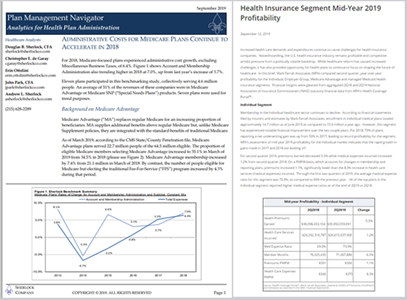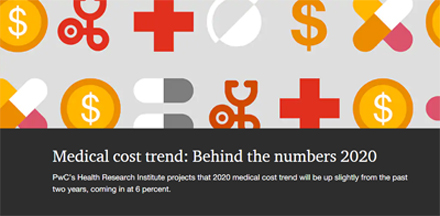By Clive Riddle, September 12, 2019
Once September is upon us and Pumpkin Spice lattes invade your nearest Starbucks, Christmas decorations should be arriving any day at your nearest Costco, and its not too early to think about what are the top issues we will be facing in the business of healthcare in new year ahead.
The Healthcare Executive Group has been doing exactly that for the past decade, presenting their top 10 list of issues at this time for the next year, have announced that for 2020 “Costs & Transparency was voted as the #1 issue/challenge facing healthcare by over 100 C-Suite and director level executives in the industry.”

HCEG explains that “executives from payer, provider and technology partner organizations were presented with a list of over 25 topics. Initially compiled from webinars, roundtables and the 2019 Industry Pulse Survey, the list was augmented by in-depth discussions during the [HCEG Annual] Forum, where industry experts explored and expounded on a broad range of current priorities within their organizations.”
Ferris W. Taylor, HCEG Executive Director in a statement comments that “It shouldn’t be surprising that costs and transparency is at the top of the list along with the consumer experience and delivery system transformation. Data, analytics, technology and interoperability are still ongoing challenges and opportunities. At the same time, executives need to be cautious, as individual health, consumer access, privacy and security are on-going challenges that also need to remain as priorities.”
Here, verbatim is the 2020 HCEG Top 10 Challenges, Issues and Opportunities:
1. Costs & Transparency - Implementing strategies and tactics to address growth of medical and pharmaceutical costs and impacts to access and quality of care.
2. Consumer Experience - Understanding, addressing and assuring that all consumer interactions and outcomes are easy, convenient, timely, streamlined, and cohesive so that health fits naturally into the “life flow” of every individual’s, family’s and community’s daily activities.
3. Delivery System Transformation - Operationalizing and scaling coordination and delivery system transformation of medical and non-medical services via partnerships and collaborations between healthcare and community-based organizations to overcome barriers including social determinants of health to effect better outcomes.
4. Data & Analytics - Leveraging advanced analytics and new sources of disparate, non-standard, unstructured, highly variable data (history, labs, Rx, sensors, mHealth, IoT, Socioeconomic, geographic, genomic, demographic, lifestyle behaviors) to improve health outcomes, reduce administrative burdens and support transition from volume to value and facilitate individual/provider/payer effectiveness.
5. Interoperability / Consumer Data Access - Integrating and improving the exchange of member, payer, patient, provider data and workflows to bring value of aggregated data and systems (EHR’s, HIE’s, financial, admin and clinical data, etc) on a near real-time and cost-effective basis to all stakeholders equitably.
6. Holistic Individual Health - Identifying, addressing and improving the member/patient’s overall medical, lifestyle/behavioral, socioeconomic, cultural, financial, educational, geographic and environmental well-being for a frictionless and connected healthcare experience.
7. Next Generation Payment Models - Developing and integrating technical and operational infrastructure and programs for a more collaborative and equitable approach to manage costs, sharing risk and enhanced quality outcomes in the transition from volume to value. (bundled payment, episodes of care, shared savings, risk-sharing, etc).
8. Accessible Points of Care - Telehealth, mHealth, wearables, digital devices, retail clinics, home-based care, micro-hospitals; and acceptance of these and other initiatives moving care closer to home and office.
9. Healthcare Policy - Dealing with repeal/replace/modification of current healthcare policy, regulations, political uncertainty/antagonism and lack of a disciplined regulatory process. Medicare-for-All, single payer, Medicare/Medicaid buy-in, block grants, surprise billing, provider directories, association health plans, and short-term policies, FHIR standards, and other mandates.
10. Privacy / Security - Staying ahead of cybersecurity threats on the privacy of consumer and other healthcare information to enhance consumer trust in sharing data. Staying current with changing landscape of federal and state privacy laws.
Corresponding with Executive Director Ferris Taylor, I asked who the list has changed and evolved during the past five years. Ferris replied that “everything has changed in healthcare in the last 5 or so years and that is reflected in the changes in the HCEG Top 10. The Affordable Care Act was really the 'accessible care act' - upwards of 20 million more people now have insurance but affordability in terms of premiums and escalating deductibles have affected everyone. It shouldn't be surprising then that cost and transparency has gone to the top of the list. For 2020, the HCEG Top 10 relate much more to how central the consumer is for all stakeholders. Healthcare is finally coming into the 21st century with digital technology, holistic individual health and a focus on the consumer journey in everything we do."

 Post a Comment By
Post a Comment By  Riddle, Clive |
Riddle, Clive |  Friday, September 20, 2019 at 11:55AM tagged
Friday, September 20, 2019 at 11:55AM tagged  Cost & Utilization|
Cost & Utilization|  Finance|
Finance|  health plans
health plans 
















